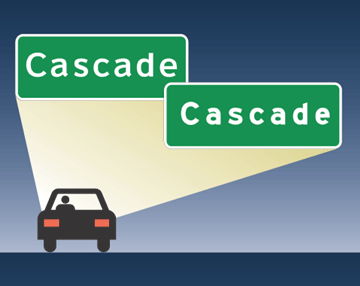
In developing a solution, Meeker retooled Highway Gothic’s lower-case letters, positive and negative color contrasts and made them more readable to America’s growing population of sight-challenged drivers. In his New York Times opinion piece, author of “The Road Taken: The History and Future of America’s Infrastructure”, Professor Henry Petroski writes the following: “As with any problem in design, the first step toward solving it is to understand how and why existing approaches fail.” The FHWA’s support and Interim Approval memo on Septempaved the way for design activism - the concept of using form to advance function. Why Design Matters aka “We Don’t Know What You Did, But the Signs Sure Are Easier to Read”
#CLEARVIEW FONT HIGHWAY DRIVERS#
This finding was buoyed by a Texas Transportation Institute at Texas A & M University study, which confirmed the importance of giving drivers with sight disability significantly more time to react to information displayed on the road. PTI studies found that compared to Highway Gothic, Clearview improved reading distance by 16% which could easily translate into 80 extra feet of reading distance or an extra 1.2 seconds of reading time for drivers travelling at 45 miles per hour. Meeker and his design team tested Clearview’s glance readability and uniformity with the Pennsylvania Transportation Institute (PTI) at Penn State University. Concluding that sign visibility was especially poor during those short minutes, he relied on his design expertise to improve safety and function, eventually creating a uniform yellow fluorescent signage system that was legible during dusk and dawn.Įquipped with life experience and funding from 3M, the Minnesota-based manufacturer whose products include Post-it notes and scotch tape, Donald Meeker, Chris O’Hara, Harriet Spear and type designer, James Montalbano, developed a way to open up the spaces between the strokes of Highway Gothic’s lower-case letters, giving birth to the Clearview font alternative. While working for the Army Corps of Engineers creating signage for rivers and waterways, Meeker set out to understand why 200 people a year died of drowning accidents during the 30-40 minutes before dusk and dawn.
#CLEARVIEW FONT HIGHWAY SERIES#
Performed in field tests for the Federal Highway Administration April 2002 at the Pennsylvania Transportation Institute Photo Credit: Donald Meeker FHWA Series E or Highway Gothic, left Clearview, right Photo Credit: Donald MeekerĮnter graphic design and wayfinding activist, Donald Meeker. Demonstration photos used to show how Clearview (bottom 4 signs) compared to Highway Gothic (top left). In addition, lower case letters like “i” and “l” were indistinguishable, with halation further heightened by the glare of headlights at night. Highway Gothic’s problems rested in the interstices (spaces) of its “a”, “e” and “u”, and when reading them at higher speed, these vowels would present more like an “o”.

#CLEARVIEW FONT HIGHWAY DRIVER#
With sign legibility and driver safety in mind, the Federal Highway Administration (FHWA) approved the use of a new typeface known as “Clearview”, agreeing that it was easier to read from a distance than its predecessor, Highway Gothic. Highway Gothic Photo Credit: Donald Meeker Clearview Photo credit: Donald Meeker The Highway Gothic vs. Younger drivers with contrast sensitive eyesight are also at risk of this blinding effect. Halation can be aggravating and dangerous, especially for the approximately 30 million licensed drivers over 70 years old in the United States (Federal Highway Administration, 2020). When headlights bounce off the reflective material on an exit sign, for example, letters and numbers become a fuzzy glow, creating a blinding effect on motorists. In graphic design and photography, there is a term called “halation” which means a blurred or “halo” effect around the edges of a letter, number or photographic image.

Or blinded by the Highway Gothic font, literally. Ever wonder why some people are late to or give up going to where they need to go, especially at night? One reason might be that they were blinded by the light, figuratively. That is, until we get to our destination, if we get to our destination. One of the few comforts of lockdown life is that we can still hit the freeways in the privacy of our vehicles, mask-less and Covid free.


 0 kommentar(er)
0 kommentar(er)
